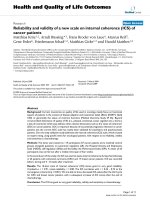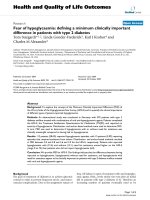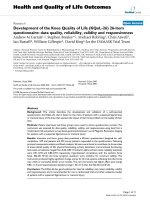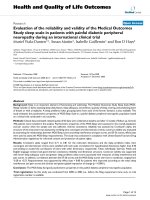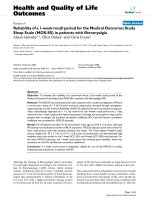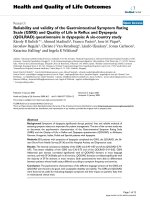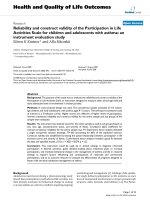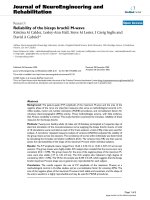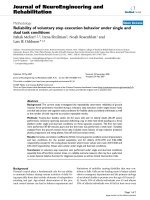Báo cáo hóa học: "RELIABILITY OF DIFFERENCE ANALOGUES TO PRESERVE STABILITY PROPERTIES OF STOCHASTIC VOLTERRA INTEGRO-DIFFERENTIAL EQUATIONS" pdf
Bạn đang xem bản rút gọn của tài liệu. Xem và tải ngay bản đầy đủ của tài liệu tại đây (796.03 KB, 22 trang )
RELIABILITY OF DIFFERENCE ANALOGUES TO PRESERVE
STABILITY PROPERTIES OF STOCHASTIC VOLTERRA
INTEGRO-DIFFERENTIAL EQUATIONS
LEONID E. SHAIKHET AND JASON A. ROBERTS
Received 2 August 2004; Revised 16 January 2005; Accepted 10 April 2005
We consider the reliability of some numerical methods in preserving the stability proper-
ties of the linear stochastic functional differential equation dx(t)
= (αx(t)+β
t
0
x(s)ds)dt
+ σx(t
−τ)dW(t), where α,β,σ, τ ≥ 0 are real constants, and W(t)isastandardWiener
process. The areas of the regions of asymptotic stability for the class of methods consid-
ered, indicated by the sufficient conditions for the discrete system, are shown to be equal
in size to each other and we show that an upper bound can be put on the time-step pa-
rameter for the numerical method for which the system is asymptotically mean-square
stable. We illustrate our results by means of numerical experiments and various stability
diagrams. We examine the extent to which the continuous system can tolerate stochastic
perturbations before losing its stability properties and we illustrate how one may accu-
rately choose a numerical method to preserve the stability properties of the original prob-
lem in the numerical solution. Our numerical experiments also indicate that the quality
of the sufficient conditions is very high.
Copyright © 2006 L. E. Shaikhet and J. A. Roberts. This is an open access article distrib-
uted under the Creative Commons Attribution License, which permits unrestricted use,
distribution, and reproduction in any medium, provided the original work is properly
cited.
1. Introduction
Volterra integro-differential equations arise in the modelling of hereditary systems (i.e.,
systems where the past influences the present) such as population growth, pollution, fi-
nancial markets and mechanical systems (see, e.g., [1, 4]). The long-term behaviour and
stability of such systems is an important area for investigation. For example—will a pop-
ulation decline to dangerously low levels? Could a small change in the environmental
conditions have drastic consequences on the long-term survival of the population? There
is a growing body of works devoted to such investigations (see, e.g., [8, 25]). Analyt-
ical solutions to such problems are generally unavailable and numerical methods are
adopted for obtaining approximate solutions. A large number of the numerical meth-
ods are developed from existing numerical methods for systems of ordinary differential
Hindawi Publishing Corporation
Advances in Difference Equations
Volume 2006, Article ID 73897, Pages 1–22
DOI 10.1155/ADE/2006/73897
2 Reliability to preserve stability properties
equations (see [24] for a discussion of some of these methods for ODEs). A natural ques-
tion to ask is “do the numerical solutions preserve the stability properties of the exact
solution?”. We refer the reader to a number of works where the answers to such questions
are investigated: [2, 3, 6, 7, 9, 28].
Many real-world phenomena are subject to random noise or perturbations (e.g., freak
weather conditions may adversely affect the supports of a bridge, possibly changing the
long-term integrity of the structure). It is a natural extension of the deterministic work
carried out by ourselves and others to consider the stability of stochastic systems and
of numerical solutions to such systems. We refer the readers to a number of texts which
discuss the role of stochastic systems in mathematical modelling: [1, 15, 27]. In particular,
stochastic integro-differential equations and its difference analogues are considered in
[5, 11–14, 26].
In this paper we consider the scalar linear test equation
dx(t)
=
αx(t)+β
t
0
x(s)ds
dt + σx(t −τ)dW(t), (1.1)
x(s)
= ϕ
0
(s), s ∈ [−τ, 0], (1.2)
where α,β,σ,τ
≥ 0 are real constants, and W(t) is a standard Wiener process. General
theory of stochastic differential equations ty pe of (1.1) was studied by Gikhman and Sko-
rokhod [10].
The selected test equation (1.1) arises from the deterministic linear test equation of
Brunner and Lambert [2]
˙
x(t)
= αx(t)+β
t
0
x(s)ds by replacing the parameter α with its
mean-value plus a stochastic perturbations type of the white noise α + σ
˙
W(t). This leads
to the stochastic differential equation dx(t)
= (αx(t)+β
t
0
x(s)ds)dt + σx(t)dW(t). An
addition of delay τ
≥ 0 in the stochastic term of this equation is a quite natural generaliza-
tion and leads to (1.1). The delay τ does not have any influence on the obtained stability
conditions but allows to demonstrate the construction of these conditions more com-
pletely. On the other hand even for τ
= 0thedifference analogue of (1.1)isadifference
equation with delay. So, an addition of delay τ does not lead to the essential complication
of the text.
When considering the stability of a system we must decide on a suitable definition
for stability. There are a number of definitions for the stability of stochastic systems. A
common choice of definition amongst numerical analysts investigating stochastic differ-
ential equations is that of mean square stability and asymptotic mean square stability. We
derive asymptotic mean square stability conditions for the linear test equation (1.1). An
analogous approach is used to derive conditions for asymptotic mean square stabilit y of
a linear stochastic difference equation. It is shown that our choice of numerical methods
are special cases of this particular difference equation, thereby allowing us to produce sta-
bility conditions for the numerical solutions to the original problem. Finally, we present
some stability diagrams and numerical experiments to illustrate our results.
L. E. Shaikhet and J. A. Roberts 3
The main conclusion of our investigation here can be formulated in the following
way: if the trivial solution of the initial functional differential equation is asymptotically
mean square stable then there exists a method and a step of discretization of this equa-
tion so that the trivial solution of the corresponding difference equation is asymptotically
mean square stable too. Moreover, it is possible to find an upper bound for the step of
discretization for which the corresponding discrete analogue preserves the properties of
stability.
The conditions for asymptotic mean square stability are obtained here by virtue of
Kolmanovskii and Shaikhet’s general method of Lyapunov functionals construction ([17–
23, 29, 31–33]) which is applicable for both differential and difference equations, both for
deterministic and stochastic systems with delay.
Let us remind ourselves of some definitions and statements which will be used.
Let
{Ω,Ᏺ,P} be a basic probability space with a family of σ-algebras f
t
⊂ Ᏺ, t ≥0, and
H be a space of f
0
-adapted functions ϕ(s), s ≤ 0. Let E be the sign for expectation.
Consider a stochastic differential equation with aftereffect
dx(t)
= a
t,x
t
dt + b
t,x
t
dW(t), x
0
= ϕ
0
∈ H. (1.3)
Hence W(t)
∈ R
m
is an m-dimensional Wiener process, the functionals a(t,ϕ) ∈ R
n
and
b(t,ϕ)
∈ R
n×m
are defined for t ≥ 0, ϕ ∈H, a(t,0) = 0, b(t,0) = 0. x
t
(s) =x(t + s), s ≤0,
isatrajectoryoftheprocessx(s)fors
≤ t.
Definit ion 1.1. The trivial solution of (1.3)iscalled
(i) mean square stable if for every
> 0 there exists a δ = δ() > 0suchthatE|x(t)|
2
<
for all t ≥ 0ifsup
s≤0
E|ϕ(s)|
2
<δ;
(ii) asymptotically mean square stable if it is mean square stable and lim
t→∞
E|x( t)|
2
=
0 for every initial function ϕ ∈H.
Let D be a space of functionals V(t,ϕ), where t
≥ 0, ϕ ∈H, for which the function
V
ϕ
(t,x) =V
t,x
t
=
V
t,x,x
t
(s), s<0
, x =x(t), ϕ =x
t
, (1.4)
has one continuous derivative with respect to t and two continuous derivatives with re-
spect to x. For each functional V from D the generator L is defined by the formula
LV(t,ϕ)
=
∂
∂t
V
ϕ
(t,x)+a
(t,ϕ)
∂
∂x
V
ϕ
(t,x)+
1
2
tr
b
(t,ϕ)
∂
2
∂x
2
V
ϕ
(t,x)b(t, ϕ)
, (1.5)
where the prime symbol
denotes transpose.
Theorem 1.2 ([16, 17]). LetthereexistafunctionalV
= V (t,ϕ) ∈D such that
EV(t,x
t
) ≥ c
1
E|x( t)|
2
,
EV(0,ϕ
0
) ≤ c
2
sup
s≤0
E
ϕ
0
(s)
2
,
ELV(t,x
t
) ≤−c
3
E|x( t)|
2
,
(1.6)
where c
i
> 0, i = 1, 2,3.Thenthetrivialsolutionof(1.3) is asymptotically mean square sta-
ble.
4 Reliability to preserve stability properties
Let
{Ω,Ᏺ,P} be a basic probability space, f
i
∈ Ᏺ, i ∈ Z ={0,1, } be a sequence of
σ-algebras, ξ
i
∈ R
m
, i ∈Z be f
i+1
-adapted and mutually independent random variables.
Suppose also that Eξ
i
= 0, Eξ
i
ξ
i
= I,whereI is an identity matrix.
Consider a stochastic difference equation
x
i+1
= a
i,x
−m
, , x
i
+ b
i,x
−m
, , x
i
ξ
i
, i ∈ Z. (1.7)
Here a
∈ R
n
, b ∈R
n×m
, a(i,0, ,0) = 0, b(i,0, ,0) = 0, x
i
= ϕ
i
, i ∈ [−m,0].
Definit ion 1.3. The trivial solution of (1.7)iscalled:
(i) mean square stable if for every
> 0 there exists δ = δ() > 0suchthatE|x
i
|
2
< ,
i
∈ Z,ifsup
i∈[−m,0]
E|ϕ
i
|
2
<δ;
(ii) asymptotically mean square stable if lim
i→∞
E|x
i
|
2
= 0 for every initial function ϕ
i
.
Theorem 1.4 [20]. Let there exist a nonnegative functional V
i
= V(i,x
−m
, , x
i
),which
satisfies the conditions
EV
0,x
−m
, , x
0
≤
c
1
sup
i≤0
E
ϕ
i
2
,
EΔV
i
≤−c
2
E
x
i
2
, i ∈ Z,
(1.8)
where c
1
> 0, c
2
> 0, ΔV
i
= V
i+1
−V
i
. Then the trivial solution of (1.7)isasymptotically
mean square stable.
2. A linear stochastic Volterra integro-differential equation
Consider (1.1). It is well known [16]thatforβ
= 0 the inequality
2α + σ
2
< 0 (2.1)
is the necessary and sufficient condition for the asymptotic mean square stability of the
trivial solution of (1.1).
If σ
= 0then(1.1) reduces to the Brunner and Lambert test equation [2] and also takes
the differential form
¨
x(t)
= α
˙
x(t)+βx(t). (2.2)
In this case the inequalities
α<0, β<0, (2.3)
are the necessary and sufficient condition for asymptotic stability of the trivial solution
of (1.1).
We proceed in the following way to obtain asymptotic mean square stability conditions
for the trivial solution of (1.1) via Lyapunov’s second method. Following conditions (2.1),
L. E. Shaikhet and J. A. Roberts 5
(2.3) we will suppose that the conditions
2α + σ
2
< 0, β<0, (2.4)
hold.
We transform (1.1) in the following way. Let
y
1
(t) =
t
0
x(s)ds, y
2
(t) = x(t). (2.5)
Then (1.1) is transform ed into the system of equations
dy
1
(t) = y
2
(t)dt
dy
2
(t) =
βy
1
(t)+αy
2
(t)
dt + σy
2
(t −τ)dW(t)
(2.6)
or in the matrix form
dy(t)
= Ay(t)dt + By(t −τ)dW(t), (2.7)
where
y
=
y
1
y
2
, A =
01
βα
, B =
00
0 σ
. (2.8)
Following the general method of Lyapunov functionals construction [17, 18]wewillcon-
struct a Lyapunov functional for (2.7)intheformV
= V
1
+ V
2
,wherethemainpartV
1
of the functional V must be chosen as a Lyapunov function for some auxiliary differential
equation without delay (in this case it is (2.7)withB
= 0). Let us choose V
1
in the form
V
1
= y
(t)Py(t)whereP =
p
11
p
12
p
12
p
22
is a positive definite matrix. Calculating for (2.7)the
generator L we obtain
ELV
1
= Ey
(t)
PA+ A
P
y(t)+Ey
(t −τ)B
PBy(t −τ). (2.9)
Let us choose the additional functional V
2
in the form
V
2
=
t
t
−τ
y
(s)B
PBy(s)ds. (2.10)
Then
ELV
2
= Ey
(t)B
PBy(t) −Ey
(t −τ)B
PBy(t −τ) (2.11)
and from (2.9), (2.11) it follows for the functional V
= V
1
+ V
2
that
ELV
= Ey
(t)
PA+ A
P + B
PB
y(t). (2.12)
Suppose that the matrix P is a positive definite solution of the matrix equation
PA+ A
P + B
PB =−I, (2.13)
6 Reliability to preserve stability properties
where I is the identity matrix. Matrix equation (2.13) is equivalent to the system of the
equations
2βp
12
=−1,
p
11
+ αp
12
+ βp
22
= 0,
2p
12
+
2α + σ
2
p
22
=−1,
(2.14)
with the solution
p
11
=
α
2β
−
1 −β
2α + σ
2
, p
12
=−
1
2β
, p
22
=
1 −β
β
2α + σ
2
. (2.15)
It is easy to check by conditions (2.4)thatp
11
> 0, p
22
> 0andp
11
p
22
>p
2
12
.There-
fore the matrix P with elements (2.15) is positive definite, as required. From here and
(2.12), (2.13) it follows that there exists a positive definite functional V, for which LV
=
−|
y(t)|
2
. Recalling our originally supposed conditions, (2.1)withβ =0, (2.4), and using
[16] we can now state the following result.
Theorem 2.1. The system of inequalities
2α + σ
2
< 0, β ≤ 0, (2.16)
is the necessary and sufficient condition for asy mptotic mean square stability of the trivial
solution of (1.1).
3. Stability of difference analogues to the integro-differential equation
Let
{Ω,Ᏺ,P} be a basic probability space, f
i
∈ Ᏺ, i ∈ Z ={0,1, } be a sequence of σ-
algebras and E be the sign for expectation. If we quantify equation (1.1) using a numerical
method based on the Euler-Maruyama scheme for the stochastic differential equation
part and a θ method to approximate the integral with a quadrature, then we obtain a
family of numerical methods of the form
x
1
= (a + b)x
0
+ σ
0
x
−m
ξ
0
,
x
2
= ax
1
+ b
θx
0
+(1−θ)x
1
+ σ
0
x
1−m
ξ
1
,
x
i+1
= ax
i
+ b
θx
0
+
i−1
j=1
x
j
+(1−θ)x
i
+ σ
0
x
i−m
ξ
i
, i ≥ 2,
a
= 1+αh, b = βh
2
, σ
0
= σh
1/2
,
(3.1)
where θ
∈ [0,1], τ = mh, h = t
i+1
− t
i
is a step of quantization, ξ
i
= h
−1/2
(W(t
i+1
) −
W(t
i
)), i ∈ Z,are f
i+1
-adapted and mutually independent random variables such that
Eξ
i
= 0, Eξ
2
i
= 1.
Note that if b
= 0 then the inequality
a
2
+ σ
2
0
< 1 (3.2)
L. E. Shaikhet and J. A. Roberts 7
is the necessary and sufficient condition for asymptotic mean square stability of the trivial
solution of (3.1)[29].
Suppose that b
= 0. We transform (3.1)fori ≥2 in the following way:
x
i+1
=
a + b(1 −θ)
x
i
+ bx
i−1
+ b
θx
0
+
i−2
j=1
x
j
+ σ
0
x
i−m
ξ
i
=
a + b(1 −θ)
x
i
+ bx
i−1
+ σ
0
x
i−m
ξ
i
+ x
i
−
a + b(1 −θ)
x
i−1
−σ
0
x
i−1−m
ξ
i−1
=
a + b(1 −θ)+1
x
i
+(bθ −a)x
i−1
+ σ
0
x
i−m
ξ
i
−σ
0
x
i−1−m
ξ
i−1
.
(3.3)
As a result we obtain (3.1)intheform
x
i+1
= Ax
i
+ Bx
i−1
+ σ
1
x
i−m
ξ
i
+ σ
2
x
i−1−m
ξ
i−1
, i ≥ 2, (3.4)
where
A
= a + b(1 −θ)+1, B = bθ −a, σ
1
= σ
0
, σ
2
=−σ
0
. (3.5)
It is known [29]thatforσ
2
= 0 the necessary and sufficient condition for asymptotic
mean square stability of the trivial solution of (3.4)is
|A| < 1 −B, |B| < 1, (3.6)
σ
2
1
<
1+B
1 −B
(1 −B)
2
−A
2
. (3.7)
We now obtain a sufficient condition for asymptotic mean square stability of the trivial
solution of (3.4) for arbitrary σ
1
and σ
2
.Let
x(i)
=
x
i−1
x
i
, A
1
=
01
BA
, B
k
=
0
σ
k
, k = 1, 2. (3.8)
Then (3.4) takes the following matrix form:
x(i +1)
= A
1
x(i)+B
1
x
i−m
ξ
i
+ B
2
x
i−1−m
ξ
i−1
. (3.9)
Using the general method of Lyapunov functionals construction [20] let us construct a
Lyapunov functional V
i
for (3.9). This method consists of four steps. On the first step of
the method we have to consider some simple auxiliary difference equation. In the case of
(3.9) the auxiliary difference equation is the equation without delay x(i +1)
= A
1
x(i) (i.e.,
(3.9)withB
1
= B
2
= 0). On the second step we have to construct a Lyapunov function v
i
for this auxiliary difference equation. Let
v
i
= x
(i)Dx(i), D =
d
11
d
12
d
12
d
22
, (3.10)
8 Reliability to preserve stability properties
and suppose that the matrix D is a positive semi-definite solution of the matrix equation
A
1
DA
1
−D =−U, U =
00
01
, (3.11)
with d
22
> 0. It is easy to check that the function v
i
is a Lyapunov function for the equation
x(i +1)
= A
1
x(i) since Δv
i
=−x
2
i
. On the third step we will construct the functional V
i
for (3.9)intheformV
i
= V
1i
+ V
2i
, where the main part V
1i
= v
i
and the additional part
V
2i
will be chosen below. Calculating EΔV
1i
= E(V
1,i+1
−V
1i
), by virtue of (3.10), (3.9)
we obtain
EΔV
1i
= E
x
(i +1)Dx(i +1)−x
(i)Dx(i)
=
E
(A
1
x(i)+B
1
x
i−m
ξ
i
+ B
2
x
i−1−m
ξ
i−1
)
×D( A
1
x(i)+B
1
x
i−m
ξ
i
+ B
2
x
i−1−m
ξ
i−1
) −x
(i)Dx(i)
=
E
x
(i)
A
1
DA
1
−D
x(i)+B
1
DB
1
x
2
i
−m
ξ
2
i
+ B
2
DB
2
x
2
i
−1−m
ξ
2
i
−1
+2B
1
DA
1
x(i)x
i−m
ξ
i
+2B
2
DA
1
x(i)x
i−1−m
ξ
i−1
+2B
1
DB
2
x
i−m
x
i−1−m
ξ
i
ξ
i−1
.
(3.12)
From (3.11) it follows that
Ex
(i)
A
1
DA
1
−D
x(i) =−Ex
2
i
. (3.13)
From (3.8), (3.10) and the properties of ξ
i
,weobtain
Ex
2
i
−m
ξ
2
i
= Ex
2
i
−m
,
Ex( i)x
i−m
ξ
i
= 0,
Ex
i−m
x
i−1−m
ξ
i
ξ
i−1
= 0,
B
2
DA
1
=
σ
2
Bd
22
,σ
2
d
12
+ Ad
22
,
B
k
DB
k
= σ
2
k
d
22
, k = 1, 2,
Ex( i)x
i−1−m
ξ
i−1
=
0,Ex
i
x
i−1−m
ξ
i−1
.
(3.14)
Using (3.4), we have
Ex
i
x
i−1−m
ξ
i−1
= E
Ax
i−1
+ Bx
i−2
+ σ
1
x
i−1−m
ξ
i−1
+ σ
2
x
i−2−m
ξ
i−2
x
i−1−m
ξ
i−1
= σ
1
Ex
2
i
−1−m
.
(3.15)
From (3.12)to(3.15)weobtain
EΔV
1i
=−Ex
2
i
+ σ
2
1
d
22
Ex
2
i
−m
+
σ
2
2
d
22
+2σ
1
σ
2
d
12
+ Ad
22
Ex
2
i
−1−m
. (3.16)
Using (3.8), (3.10)wehave
A
1
DA
1
=
B
2
d
22
B
d
12
+ Ad
22
B
d
12
+ Ad
22
d
11
+2Ad
12
+ A
2
d
22
. (3.17)
L. E. Shaikhet and J. A. Roberts 9
Using (3.17) one can transform matrix equation (3.11) into the system of equations
B
2
d
22
−d
11
= 0,
B
d
12
+ Ad
22
−
d
12
= 0,
d
11
+2Ad
12
+ A
2
d
22
−d
22
=−1.
(3.18)
The solution of system (3.18)hastheform
d
11
= B
2
d
22
,
d
12
=
AB
1 −B
d
22
,
d
22
=
1+B
1 −B
(1 −B)
2
−A
2
−1
.
(3.19)
Note that d
22
> 0 if and only if condition (3.6) holds. Substituting (3.19)into(3.16), we
have
EΔV
1i
=−Ex
2
i
+ σ
2
1
d
22
Ex
2
i
−m
+ γd
22
Ex
2
i
−1−m
, (3.20)
where
γ
= σ
2
2
+2σ
1
σ
2
A
1 −B
. (3.21)
Letting γ
0
= max(γ,0) we can at last (the four th step of the method) by some standard
way choose the additional functional
V
2i
= d
22
σ
2
1
+ γ
0
m
j=1
x
2
i
−j
+ γ
0
x
2
i
−1−m
. (3.22)
It follows that
ΔV
2i
= d
22
σ
2
1
+ γ
0
m
j=1
x
2
i+1
−j
−
m
j=1
x
2
i
−j
+ γ
0
x
2
i
−m
−x
2
i
−1−m
=
d
22
σ
2
1
+ γ
0
x
2
i
−x
2
i
−m
+ γ
0
x
2
i
−m
−x
2
i
−1−m
=
d
22
σ
2
1
+ γ
0
x
2
i
−σ
2
1
x
2
i
−m
−γ
0
x
2
i
−1−m
.
(3.23)
So, using (3.16), (3.23) for the functional V
i
= V
1i
+ V
2i
we have
EΔV
i
=−
1 −d
22
σ
2
1
+ γ
0
Ex
2
i
+ d
22
γ −γ
0
Ex
2
i
−1−m
. (3.24)
If γ
≥ 0thenγ
0
= γ and, using (3.21), we obtain
EΔV
i
=−
1 −d
22
σ
2
1
+2σ
1
σ
2
A
1 −B
+ σ
2
2
Ex
2
i
. (3.25)
10 Reliability to preserve stability properties
From here and representation (3.18)ford
22
it follows [29]thatifγ ≥0 then the inequality
σ
2
1
+2σ
1
σ
2
A
1 −B
+ σ
2
2
<
1+B
1 −B
(1 −B)
2
−A
2
(3.26)
is the necessary and sufficient condition for asymptotic mean square stability of the trivial
solution of (3.4).
Consider now the situation if γ<0. In this case γ
0
= 0and(3.24) takes the form
EΔV
i
=−
1 −σ
2
1
d
22
Ex
2
i
+ γd
22
Ex
2
i
−1−m
. (3.27)
So, if γ<0 then the inequality σ
2
1
d
22
< 1isasufficient condition for asymptotic mean
square stability of the trivial solution of (3.4). Let us suppose that γ<0andσ
2
1
d
22
≥ 1.
Summing (3.27)fromi
= 0toi =n,wehave
EV
n+1
−EV
0
=−
1 −σ
2
1
d
22
n
i=0
Ex
2
i
+ γd
22
n−1−m
i=0
Ex
2
i
+
−1
i=−1−m
Ex
2
i
. (3.28)
From here, using V
n+1
≥ 0andγ<0, we obtain
1 −σ
2
1
d
22
n
i=0
Ex
2
i
−γd
22
n
−1−m
i=0
Ex
2
i
≤ EV
0
. (3.29)
or
1 −d
22
σ
2
1
+ γ
n
i=0
Ex
2
i
≤ EV
0
+ |γ|d
22
n
i=n−m
Ex
2
i
. (3.30)
Note that by virtue of (3.6)wehave
σ
2
1
+ γ = σ
2
1
+2σ
1
σ
2
A
1 −B
+ σ
2
2
>σ
2
1
−2
σ
1
σ
2
+ σ
2
2
=
σ
1
−
σ
2
2
≥ 0. (3.31)
Therefore, by condition (3.26), that is equivalent to d
22
(σ
2
1
+ γ) < 1, each mean square
bounded solution of (3.4), that is, Ex
2
i
≤ C, satisfies the condition lim
i→∞
Ex
2
i
= 0.
So by condition (3.26) the mean square bounded solution of (3.4)isasymptotically
mean square trivial, that is, lim
i→∞
Ex
2
i
= 0. Note also that for σ
2
= 0 condition (3.26)
coincides with (3.1).
Using (3.5), (3.6), we rewrite condition (3.26)intermsoftheparametersof(3.1):
σ
2
0
< (1 −a + bθ)
1+a −b
θ −
1
2
,
b
θ −
1
2
−
1 <a<bθ+1, −4 <b<0.
(3.32)
If b
→ 0 then condition (3.32)takesform(3.2). Conditions (3.32), (3.2) can also be writ-
ten in the form
a −
θ −
1
4
b
2
+ σ
2
0
<
1+
b
4
2
(3.33)
L. E. Shaikhet and J. A. Roberts 11
b
0
−1
−2
−3
−4
−3 −2
a
543 21
Figure 3.1. Stability diagram, σ
0
= 0, differing θ values.
b
0
10
9
8
7
6
5
4
3
2
1
−1−2−3
−4
−3
−2
−1
1 a
Figure 3.2. Stability diagram, θ =1, differing σ
2
0
values.
or
θ −
1
4
b −
1+
b
4
2
−σ
2
0
<a<
θ −
1
4
b +
1+
b
4
2
−σ
2
0
, −4
1 −
σ
0
<b≤ 0.
(3.34)
Stability regions, obtained by virtue of condition (3.34)forσ
0
= 0anddifferent values of
θ are shown in Figure 3.1 with the following key: (1) θ
= 0, (2) θ = 0.25, (3) θ = 0.5, (4)
θ
= 0.75, (5) θ =1.
12 Reliability to preserve stability properties
b
0
10
9
8
7
6
5
4
3
2
1
−1−2−3
−4
−3
−2
−1
1 a
Figure 3.3. Stability diagram, θ =0.375, differing σ
2
0
values.
Stability regions, obtained by virtue of condition (3.34)forθ = 1anddifferent values
of σ
2
0
are shown in Figure 3.2 with the following key: (1) σ
2
0
= 0, (2) σ
2
0
= 0.1, (3) σ
2
0
=
0.2, (4) σ
2
0
= 0.3, (5) σ
2
0
= 0.4, (6) σ
2
0
= 0.5, (7) σ
2
0
= 0.6, (8) σ
2
0
= 0.7, (9) σ
2
0
= 0.8, (10)
σ
2
0
= 0.9. Figure 3.3 uses the same key as Figure 3.2 and is for θ =0.375.
Remark 3.1. Note that the stability region, given by condition (3.34)dependsonθ and
σ
0
,buttheareaS of this stability region depends on σ
0
only and does not depend on θ,
that is, S
= S(σ
0
). It is easy to see that
S
σ
0
=
2
0
−4(1−|σ
0
|)
1+
b
4
2
−σ
2
0
db. (3.35)
Putting t
= x +
x
2
−σ
2
0
, x =1+b/4, one can show that
S
σ
0
=
4
1 −σ
2
0
−σ
2
0
ln
1+
1 −σ
2
0
σ
0
. (3.36)
In particular, S(0)
= 4, S(0.5) =2
√
3 −ln(2 +
√
3) > 2, S(1) = 0.
Stability condition (3.34) in the terms of initial equation (1.1) takes the form
1
h
−
1+
θ −
1
4
βh
2
−
1+
1
4
βh
2
2
−σ
2
h
<α
<
1
h
−1+
θ −
1
4
βh
2
+
1+
1
4
βh
2
2
−σ
2
h
, −4
1 −|σ|h
1/2
<βh
2
≤ 0.
(3.37)
L. E. Shaikhet and J. A. Roberts 13
11
10
9
8
7
6
5
4
3
2
1
5
4
3
−1500
−1000
−500
α
β
−75
−50 −25−100
1
Figure 3.4. Stability diagram, θ =1, σ
2
= 0, differing h values.
11
10
9
8
7
6543215
4
3
−1500
−1000
−500
α
β
−75
−50 −25−100
1
Figure 3.5. Stability diagram, θ =1, σ
2
= 1, differing h values.
Thestabilityregionsinthe(α,β) space, obtained by condition (3.37)forθ = 1, σ
2
= 0
are shown in Figure 3.4 for different values of the step size h of the numerical method,
using the following key: (1) h
= 0, (2) h = 0.01, (3) h = 0.02, (4) h = 0.03, (5) h = 0.04,
(6) h
= 0.05, (7) h = 0.06, (8) h =0.07, (9) h = 0.08, (10) h = 0.1, (11) h = 0.15. Figures
3.5 and 3.6 show similar pictures with θ
= 1andh as indicated above but with σ
2
= 1and
σ
2
= 3 respectively.
14 Reliability to preserve stability properties
11
10
9
8
7
6
5432154
3
−1500
−1000
−500
α
β
−75
−50 −25−100
1
Figure 3.6. Stability diagram, θ =1, σ
2
= 3, differing h values.
54 3 21
−1500
−1000
−500
α
β
−50 −25
Figure 3.7. Stability diagram, σ
2
= 1, h = 0.05, differing θ values.
Figure 3.7 illustrates the stability region in the (α,β)spaceforσ
2
= 1, h = 0.05 and
different values θ (i.e., different numerical schemes) according to the following key: (1)
θ
= 0, (2) θ =0.25, (3) θ = 0.5, (4) θ =0.75, (5) θ = 1.
If we calculate the infimum with respect to θ in the left-hand part and the supremum
in the right-hand part of inequalities (3.37)weobtain
1
h
−1+
3
4
βh
2
−
1+
1
4
βh
2
2
−σ
2
h
<α
<
1
h
−
1 −
1
4
βh
2
+
1+
1
4
βh
2
2
−σ
2
h
, −4
1 −|σ|h
1/2
<βh
2
≤ 0.
(3.38)
L. E. Shaikhet and J. A. Roberts 15
4
3
2
1
−300
−200
−100
α
β
−30 −20 −10
0
Figure 3.8. Stability diagram, h = 0.1, differing σ
2
values.
4
3
2
1
0
−1000
−2000
−100 −50
α
β
Figure 3.9. Stability diagram, σ
2
= 1, differing h values.
It is easy to check that if h → 0 then condition (3.38) coincides with condition (2.16). It
leads to the following useful statement.
Theorem 3.2. If α, β and σ satisfy condition (2.16) then there exists a small enough h such
that condition (3.38)holdstoo.Andifα, β, σ and h satisfy condition (3.38) then there exists
a θ
∈ [0,1] such that condition (3.37) holds too and therefore the trivial solution of (3.1)is
asymptotically mean square stable.
The stability regions obtained by condition (3.38)forh
= 0.1anddifferent values of
σ are shown in Figure 3.8, according to the following key: (1) σ
2
= 0.5, (2) σ
2
= 1, (3)
σ
2
= 2, (4) σ
2
= 3. Figure 3.9 shows a similar picture for σ
2
= 1anddifferent values of h:
(1) h
= 0.1, (2) h =0.065, (3) h =0.045, (4) h = 0.035.
16 Reliability to preserve stability properties
54 3
2
1
−1500
−1000
−500
0
α
β
−50 −25
B
2
B
1
E
1
E
2
C
1
C
2
D
2
D
1
A
1
A
2
Figure 4.1. Stability diagram, σ
2
= 1, h = 0.05, differing θ values.
4. Upper bound for the step of discretization
From condition (3.37) it follows that f (h) > 0where
f (h):
= θ
θ −
1
2
β
2
h
3
−
2θ −
1
2
αβh
2
+
α
2
−2βθ
h +2α + σ
2
. (4.1)
Using the representation (4.1) consider different possible cases for determining an upper
bound for the step of discretization.
4.1. Case β
= 0. Let β = 0. From (4.1), (2.16)weobtain f (h) = α
2
h +2α + σ
2
< 0for
h
∈ [0, h
1
), where
h
1
=−
2α + σ
2
α
2
> 0. (4.2)
For example, if α
=−30, β = 0, σ
2
= 1thenh
1
≈ 0.0656. Changing α to α =−40, we
obtain h
1
≈ 0.0494. On Figure 4.1 which coincides with Figure 3.7 (σ
2
= 1, h = 0.05) the
points A
1
(−30,0) and A
2
(−40,0) are shown. One can see that the point A
1
belongs to the
stability region but the point A
2
does not belong since h = 0.05 >h
1
= 0.0494.
Suppose now that β<0 and consider the following possibilities for θ.
4.2. Case θ
= 0. Let θ =0. Then
f (h)
=
1
2
αβh
2
+ α
2
h +2α + σ
2
. (4.3)
Since 2α + σ
2
< 0andαβ > 0then f (h) < 0forh ∈ [0,h
1
), where
h
1
=
α
4
−2αβ
2α + σ
2
−
α
2
αβ
> 0. (4.4)
L. E. Shaikhet and J. A. Roberts 17
For example, if α
=−10, β =−1000, σ
2
= 1thenh
1
≈ 0.0524. Changing β to β =−1200
we obtain h
1
≈ 0.0486 < 0.05. On Figure 4.1 the point B
1
(−10,−1000) belongs to the
stability region with θ
= 0 and the point B
2
(−10,−1200) does not belong.
4.3. Case θ
= 1/2. Let θ =1/2. Then
f (h)
=−
1
2
αβh
2
+
α
2
−β
h +2α + σ
2
. (4.5)
Since
D
=
α
2
−β
2
+2αβ
2α + σ
2
) =
α
2
+ β
2
+2αβσ
2
> 0 (4.6)
then f (h) < 0forh
∈ [0, h
1
), where
h
1
=
α
2
−β −
√
D
αβ
> 0. (4.7)
For example, if α
=−30, β =−1000, σ
2
= 1thenh
1
≈ 0.0545. Changing β on β =−1200
we obtain h
1
≈ 0.0472. On Figure 4.1 the point C
1
(−30,1000) belongs to the stability
region with θ
= 1/2 and the p oint C
2
(−30,−1200) does not belong to this region.
4.4. Case θ
∈ (1/2,1]. Let θ ∈ (1/2, 1]. From (4.1)and(2.16) it follows that f (h) < 0for
h
≤ 0. So f (h) < 0forh ∈[0,h
1
), where h
1
is the least root of the equation f (h) = 0. For
example, if α
=−40, β =−1000, σ
2
= 1, θ =0.75 we obtain
f (h)
= 187500h
3
−40000h
2
+ 3100h −79 = 0 (4.8)
and h
1
≈ 0.0511. Changing β to β =−1200 we obtain
f (h)
= 270000h
3
−48000h
2
+ 3400h −79 = 0 (4.9)
with h
1
≈ 0.0431. On Figure 4.1 the point D
1
(−40,−1000) belongs to the stability region
with θ
= 3/4 but the point D
2
(−40,−1200) does not belong to this region.
4.5. Case θ
∈ (0, 1/2). Let θ ∈ (0, 1/2). From (4.1)and(2.16) it follows that f (0) < 0and
(df /dh)(0) > 0. It means that f (h) < 0forh
∈ [0, h
1
)whereh
1
is the least positive root of
the equation f (h)
= 0. For example, if α =−20, β =−1200, σ
2
= 1, θ =1/4then
f (h)
=−90000h
3
+ 1000h −39 (4.10)
and h
1
≈ 0.0508. Changing β to β =−1300 we obtain
f (h)
=−105625h
3
+ 1050h −39 = 0 (4.11)
with h
1
≈ 0.0489. On Figure 4.1 the point E
1
(−20,−1000) belongs to the stability region
with θ
= 1/4 but the point E
2
(−20,−1300) does not belong to this region.
18 Reliability to preserve stability properties
109876543210
−2.5
−2
−1.5
−1
−0.5
0
0.5
1
1.5
2
2.5
τ
= ih
X
t
Figure 5.1. Trajectories of (3.1) with m = 0, α =−55, β =−1000, σ
2
= 1, h = 0.05, θ = 1, x
0
= 1.
109876543210
−2
−1.5
−1
−0.5
0
0.5
1
1.5
×10
13
τ = ih
X
t
Figure 5.2. Trajectories of (3.1) with m = 0, α =−55, β =−1000, σ
2
= 1, h = 0.06, θ = 1, x
0
= 1.
5. Numerical experiments
We illustrate some of our results with trajectories of (3.1). Note that in [30]anabsolute
correspondence of asymptotic mean square stability of the trivial solution and conver-
gence of trajectories to zero was shown.
Figure 5.1 shows 50 tr ajectories of (3.1)withm
= 0 (i.e., without delay), x
0
= 1, α =
−
55, β =−1000, σ
2
= 1, h =0.05, θ = 1. The dark line represents the arithmetic mean of
the trajectories, as it does for all the figures in this section. It is clear that we have a stable
L. E. Shaikhet and J. A. Roberts 19
109876543210
−2500
−2000
−1500
−1000
−500
0
500
1000
1500
2000
2500
τ
= ih
X
t
Figure 5.3. Trajectories of (3.1) with m = 0, α =−40, β =−25, σ
2
= 1, h = 0.05, θ = 0, x
0
= 1.
151050
−10
−8
−6
−4
−2
0
2
4
6
8
10
τ
= ih
X
t
Figure 5.4. Trajectories of (3.1) with m = 0, α =−40, β =−25, σ
2
= 1, h = 0.05, θ = 1, x
0
= 1.
system. If we change the parameter h to h = 0.06 we no longer have a stable system (as
shown in Figure 5.2, as expected from examining Figure 3.5).
Figure 3.7 shows the regions of stability for different θ methods. We illustrate this point
with Figures 5.3, 5.4 and 5.5. Each figure shows 50 trajectories with identical parameter
values except for θ.ForFigure 5.3 θ
= 0, for Figure 5.4 θ = 1, and for Figure 5.5 θ = 0.5.
The interesting point here is that for particular parameter values where the integro-
differential equation is asymptotically mean square stable we can choose a θ method
20 Reliability to preserve stability properties
20181614121086420
−300
−200
−100
0
100
200
300
τ
= ih
X
t
Figure 5.5. Trajectories of (3.1) with m = 0, α =−40, β =−25, σ
2
= 1, h = 0.05, θ = 0.5, x
0
= 1.
20181614121086420
−4
−3
−2
−1
0
1
2
3
4
5
τ
= ih
X
t
Figure 5.6. Trajectories of (3.1) with m = 0, α =−39, β =−25, σ
2
= 1, h = 0.05, θ = 0, x
0
= 1.
which replicates this stability property. In Figure 5.3 the sufficient conditions for asymp-
totic mean square stability of the discrete system (i.e.,
−38.8603 <α<−0.5147, given
the other parameters) are not satisfied and the trajectories are indeed unstable, whereas
in Figures 5.4 and 5.5 the conditions (i.e.,
−40.1103 <α<−1.7647 for Figure 5.4 and
−39.4853 <α<−1.1397 for Figure 5.5, given the other parameters) are satisfied and we
have asymptotic mean-square stability. Figure 5.6 uses the same parameters as Figure 5.3
except that α
=−39. In this case the sufficient conditions are not satisfied for the discrete
analogue (we are very close to satisfying them though) but we still have asymptotic mean
L. E. Shaikhet and J. A. Roberts 21
square stability, thus verifying that are conditions are only sufficient and not necessary
and sufficient. However we believe our experiments indicate that the sufficient condi-
tions are very good ones.
Acknowledgments
This work has been completed with the financial assistance of NATO, grant reference
PST.EV.979727, to whom the authors wish to express their thanks. We would also like to
thank Dr John Edwards and Prof Neville Ford of University College Chester for helpful
comments relating to early drafts of the work.
References
[1] V.N.Afanas’ev,V.B.Kolmanovskii,andV.R.Nosov,Mathematical Theory of Control Systems
Design, Mathematics and Its Applications, vol. 341, Kluwer Academic, Dordrecht, 1996.
[2] H. Brunner and J. D. Lamber t, Stability of numerical methods for Volterra integro-differential
equations, Computing (Arch. Elektron. Rechnen) 12 (1974), no. 1, 75–89.
[3] H. Brunner and P. J. van der Houwen, The Numerical Solution of Volterra Equations, CWI Mono-
graphs, vol. 3, North-Holland, Amsterdam, 1986.
[4] S. Busenberg and K. L. Cooke, The effect of integral conditions in c ertain equations modelling
epidemics and population growth, Journal of Mathematical Biology 10 (1980), no. 1, 13–32.
[5] A. Drozdov, Explicit stability condit ions for stochastic integro-differential equations with non-
selfadjoint operator coefficients, Stochastic Analysis and Applications 17 (1999), no. 1, 23–41.
[6] J.T.Edwards,N.J.Ford,andJ.A.Roberts,The numerical simulation of the qualitative behaviour
of Volterra integro-differential equations, Proceedings of Algorithms for Approximation IV (Hud-
dersfield, 2001) (J. Levesley, I. J. Anderson, and J. C. Mason, eds.), University of Huddersfield,
Huddersfield, 2002, pp. 86–93.
[7] J.T.Edwards,N.J.Ford,J.A.Roberts,andL.E.Shakhet,Stability of a discrete nonlinear integro-
differential equation of convolution type, Stability and Control: Theory and Applications. An In-
ternational Journal 3 (2000), no. 1, 24–37.
[8] S. Elaydi and S. Sivasundaram, A unified approach to stability in integrodifferential equations via
Liapunov functions, Journal of Mathematical Analysis and Applications 144 (1989), no. 2, 503–
531.
[9] N.J.Ford,C.T.H.Baker,andJ.A.Roberts,Nonlinear Volterra integro-differential equations—
stability and numerical stability of θ-methods, Journal of Integral Equations and Applications 10
(1998), no. 4, 397–416.
[10] I. I. Gihman and A. V. Skorokhod, Stochastic Differential Equations, Izdat. Naukova Dumka,
Kiev, 1968.
[11] J. Golec and S. Sathananthan, Sample path approximation for stochastic integro-differential equa-
tions, Stochastic Analysis and Applications 17 (1999), no. 4, 579–588.
[12]
, Strong approximations of stochastic integro-differential equations, Dynamics of Contin-
uous, Discrete & Impulsive Systems. Series B. Applications & Algorithms 8 (2001), no. 1, 139–
151.
[13] D.J.Higham,X.R.Mao,andA.M.Stuart,Strong convergence of Euler-type methods for nonlinear
stochastic differential equations,SIAMJournalonNumericalAnalysis40 (2002), no. 3, 1041–
1063.
[14]
, Exponential mean-square stability of numerical solutions to stochastic differential equa-
tions, LMS Journal of Computation and Mathematics 6 (2003), 297–313.
[15] P. E. Kloeden and E. Platen, Numerical Solution of Stochastic Differential Equations,Applications
of Mathematics (New York), vol. 23, Springer, Berlin, 1992.
22 Reliability to preserve stability properties
[16] V. B. Kolmanovskii and A. Myshkis, Applied Theory of Functional-Differential Equations,Math-
ematics and Its Applications (Soviet Series), vol. 85, Kluwer Academic, Dordrecht, 1992.
[17] V. B. Kolmanovskii and L. E. Shaikhet, A method for constructing Lyapunov functionals for sto-
chastic systems with aftereffect,Differentsial’nye Uravneniya 29 (1993), no. 11, 1909–1920, 2022
(Russian), translation in Differential Equations 29 (1993), no. 11, 1657–1666 (1994).
[18]
, New results in stability theory for stochastic functional-differential equations (SFDEs) and
their applications, Proceedings of Dynamic Systems and Applications, Vol. 1 (Atlanta, GA, 1993),
Dynamic, Georgia, 1994, pp. 167–171.
[19]
, A method for constructing Lyapunov functionals for stochastic differenti al equations of
neutral type,Differentsial’nye Uravneniya 31 (1995), no. 11, 1851–1857, 1941, translation in
Differential Equations 31 (1995), no. 11, 1819–1825 (1996).
[20]
, General method of Lyapunov functionals construction for stability investigation of stochas-
tic difference equations, Dynamical Systems and Applications, World Sci. Ser. Appl. Anal., vol. 4,
World Scientific, New Jersey, 1995, pp. 397–439.
[21]
, Construction of Lyapunov functionals for stochastic hereditar y systems: a survey of some
recent results, Mathematical and Computer Modelling 36 (2002), no. 6, 691–716.
[22]
, Some peculiarities of the general method of Lyapunov functionals construction,Applied
Mathematics Letters. An International Journal of Rapid Publication 15 (2002), no. 3, 355–360.
[23]
, About one application of the general method of Lyapunov functionals construction, Inter-
national Journal of Robust and Nonlinear Control 13 (2003), no. 9, 805–818, Special issue on
Time-Delay Systems, RNC.
[24] J. D. Lambert, Numerical Methods for Ordinary Differential Systems: The Initial Value Problem,
John Wiley & Sons, Chichester, 1991.
[25] J. J. Levin and J. A. Nohel, Note on a nonlinear Volterra equation, Proceedings of the American
Mathematical Society 14 (1963), 924–929.
[26] X. R. Mao, Stability of stochastic integro-differential equations, Stochastic Analysis and Applica-
tions 18 (2000), no. 6, 1005–1017.
[27] B. Øksendal, Stochastic Differential Equations: An Introduction with Applications, 5th ed., Uni-
versitext, Springer, Berlin, 1998.
[28] Y. Saito and T. Mitsui, Stability analysis of numerical schemes for stochast ic differential equations,
SIAM Journal on Numerical Analysis 33 (1996), no. 6, 2254–2267.
[29] L. E. Shaikhet, Necessary and sufficie nt conditions of asymptotic mean square stability for stochas-
ticlineardifference equations, Applied Mathematics Letters. An International Journal of Rapid
Publication 10 (1997), no. 3, 111–115.
[30]
, Numerical simulation and stability of stochastic systems with Markovian switching,Neu-
ral, Parallel & Scientific Computations 10 (2002), no. 2, 199–208.
[31]
, About Lyapunov functionals construction for difference equations with continuous time,
Applied Mathematics Letters. An International Journal of Rapid Publication 17 (2004), no. 8,
985–991.
[32]
, Construction of Lyapunov functionals for stochastic difference equations with continuous
time, Mathematics and Computers in Simulation 66 (2004), no. 6, 509–521.
[33]
, Lyapunov functionals construction for stochastic difference second-kind Volterra equations
with continuous time,AdvancesinDifference Equations 2004 (2004), no. 1, 67–91.
Leonid E. Shaikhet: Department of Higher Mathematics,
Donetsk State University of Management, Donetsk 83015, Ukraine
E-mail address:
Jason A. Roberts: Mathematics Department, University of Chester,
Chester CH14BJ, England
E-mail address:
